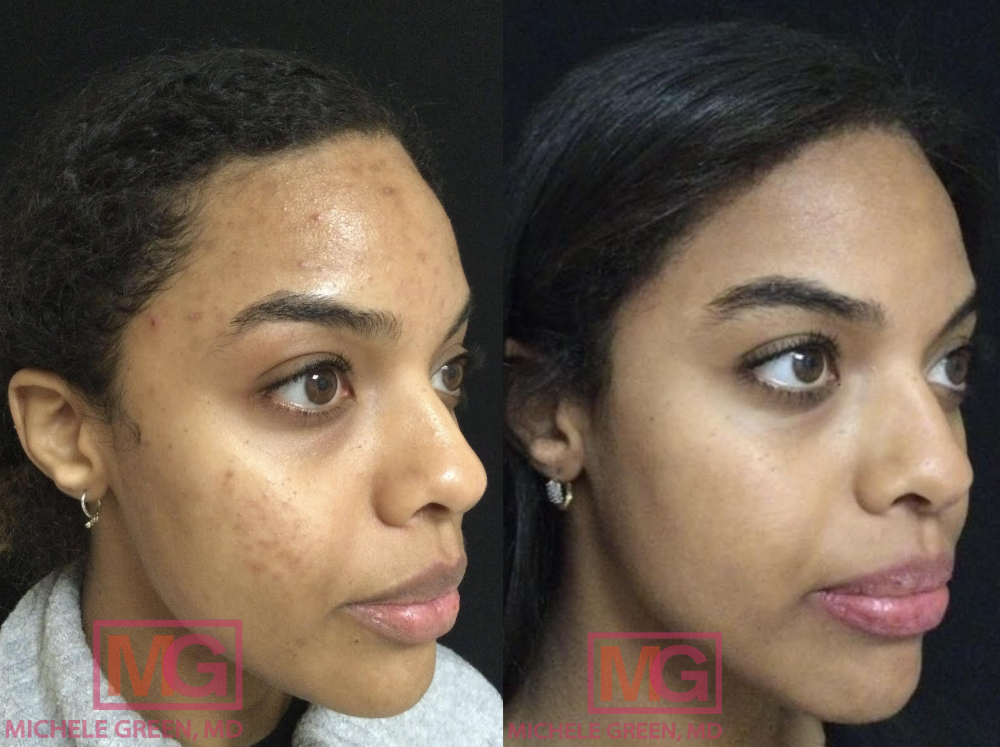Hormonal Acne Treatment
Many people assume that hormonal acne breakouts will disappear after their teenage years. Unfortunately, many adults struggle with persistent acne for years following puberty. Hormonal acne is one specific type of adult acne vulgaris that may occur in both men and women; however, it is most prevalent among women between 20 and 40 years of age. Women who experience hormonal acne breakouts often observe cystic pimples along the jawline, chin, and cheeks, occurring in a cyclical breakout pattern. Hormonal acne breakouts may be related to several changes, such as a change or discontinuation of birth control, menstruation, menopause, or pregnancy. Breakouts of hormonal acne may appear out of the blue after years of completely clear skin and can be frustrating and challenging to treat. Luckily, board-certified dermatologist Dr. Michele Green in NYC is here to help.
Although hormone fluctuations play a role in most forms of adult acne, the direct relationship between hormone levels and acne breakouts is still not entirely understood. Hormonal acne breakouts are often triggered by the production of excess androgens, or male hormones, in the body, which leads to sebum overproduction and clogged pores. Hormonal acne can be particularly challenging to treat, as these breakouts often don’t respond well to other acne treatments like oral antibiotics and topical skincare. While this type of acne flare-up is frustrating for many, Dr. Green employs various oral medications, topical creams, in-office treatments, and skin care products in her patient’s treatment plans to manage and eliminate hormonal acne for blemish-free, radiant skin.
Dr. Michele Green is a world-renowned, board-certified dermatologist with over 25 years of experience in medical and cosmetic dermatology, including hormonal acne treatment and acne scar reduction. She is consistently identified as one of New York’s best dermatologists by Castle Connolly, New York Magazine, Super Doctors, and the New York Times for her dedication to her patients and expertise. She developed her skincare line, MGSKINLABS, to treat various skin conditions, from acne breakouts to various signs of aging. When you consult with Dr. Green, she will work with you to create a customized hormonal acne treatment plan suited to the type and severity of your hormonal acne to help you achieve and maintain clear, healthy, smooth skin.
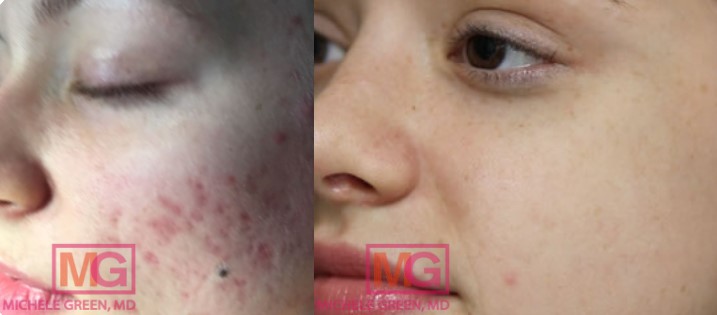
25-34 year old woman treated with acne scar treatment
What is hormonal acne?
Hormonal acne is acne breakouts linked to the overproduction of sebum from the skin’s sebaceous oil glands. The excess oil clogs pores with acne-causing bacteria, leading to the formation of pimples, painful cysts, and comedones (commonly referred to as blackheads and whiteheads). While hormonal acne is typically associated with puberty, it also affects adults, typically between the ages of 20 and 40. Both men and women can experience hormonal acne, although women are much more likely to have hormonal acne breakouts.
What is hormonal acne triggered by?
As the name suggests, hormonal acne is triggered by fluctuations in hormone levels, particularly testosterone, estrogen, and progesterone, that lead to increased oil production in the skin’s sebaceous glands. Hormonal acne breakouts can develop at any age. Teenagers experience hormonal acne due to fluctuating hormones during puberty. Endocrine disorders like hypothyroidism can also cause hormonal acne breakouts in both adolescence and adulthood. Hormonal acne is more prevalent in adult female patients than adult male patients due to several factors, including hormonal fluctuations during menstrual cycles, pregnancy, menopause, and polycystic ovary syndrome (PCOS). Many women experience hormonal acne breakouts the week before or during their menstrual cycle. Progesterone levels are elevated in the second half of the menstrual cycle, which can stimulate excess oil production in the skin and additionally cause the skin’s pores to swell shut, trapping excess sebum, dead skin cells, and other debris in the pores. During menopause, many women experience hormonal acne due to a shift in hormone levels. Menopause is typically marked by a decrease in estrogen and an increase in androgen hormones like testosterone, which can lead to more blemishes. With PCOS, androgen hormones such as testosterone are elevated, leading to increased oil production, clogged pores, and acne formation.
What are the characteristics of hormonal acne?
Hormonal acne can occur anywhere on the body where there are sebaceous glands, but it is most often found on areas of the lower face, including the chin, jawline, and cheeks. In younger individuals experiencing hormonal acne breakouts related to puberty, the t-zone is generally the area most affected (forehead, nose, and chin). While less common, hormonal acne breakouts may also occur on the chest and back. Hormonal acne can form as various types of acne lesions, such as small pimples, cysts, blackheads, whiteheads, nodules, papules, and pustules. Inflammatory acne lesions such as cysts and pustules may be deep, red, and painful and often leave acne scars that are harder to treat than the acne itself.
How do you know if acne is hormonal?
Hormonal acne breakouts can be identified through a few key characteristics. If you are experiencing acne breakouts and are no longer in your teen years, you may be experiencing hormonal adult acne. Additionally, if you experience fluctuations in acne breakouts in a cyclical pattern, you may be dealing with hormonal acne. Often, patients with hormonal acne experience breakouts more intensely once a month. Increased stress can also have a significant impact on hormonal acne breakouts. Acne breakouts during events such as menstruation, pregnancy, and menopause, after changing or starting certain oral medications, or during medical conditions that cause hormonal changes are also indicative of hormonal acne. Hormonal acne blemishes appear most commonly in the t-zone during puberty but typically appear along the jawline and lower face in cases of adult hormonal acne. When you consult with an expert, such as board-certified dermatologist Dr. Michele Green, your adult acne can be properly diagnosed and treated. In addition to physically evaluating your skin condition, Dr. Green will collect a thorough medical history and potentially order specific blood tests to determine any irregular hormone levels.
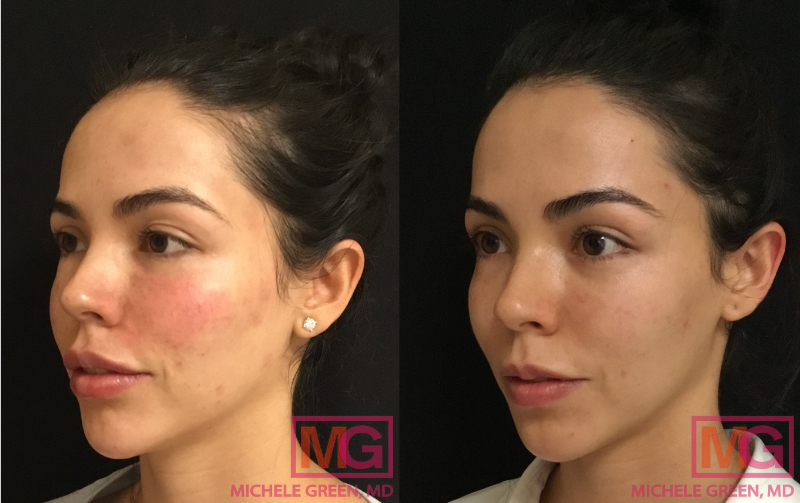
Vbeam, 2 months before and after
Is hormonal acne the same as adult acne?
Hormonal acne is a variety of adult acne. Still, adult acne can be caused by various issues, including naturally oily skin, clogged hair follicles, poor diet, stress, an overgrowth of acne-causing bacteria on the skin, or irritants such as make-up or fabric. A typical example of non-hormonal acne is mask acne or “maskne,” which was a skin condition that affected many individuals during the COVID-19 pandemic. Alternatively, hormonal acne is specifically caused by fluctuating hormone levels, leading to increased oil production in the skin. Many patients with hormonal acne experience breakouts in a cyclical pattern and tend to have pimples on the chin, cheeks, and jawline.
How does a dermatologist diagnose hormonal acne?
It is always recommended to consult with a board-certified dermatologist regarding acne breakouts, especially if the acne is persistent, recurring, or cystic. This is because acne, particularly inflammatory acne-like cysts, can cause permanent scars. Acne scars develop due to inflammation associated with the lesions, causing irreparable damage to the underlying skin tissue. While cosmetic procedures are available to improve the appearance of acne scars, the best treatment is the prevention of the acne breakouts themselves. A dermatologist such as Dr. Green can evaluate the patterns of acne breakouts, the severity of the breakouts, and the types of acne present during a physical assessment. In addition, other contributing factors will be discussed, including skincare regimen, family history of acne, lifestyle habits, and other underlying health conditions. Dr. Green may also order blood tests to determine whether an imbalance in certain hormone levels contributes to the breakouts. Afterward, Dr. Green will discuss the best treatment options suited to your specific hormonal acne to help you achieve and maintain healthy, smooth skin.
How do I stop hormones from giving me acne?
The first step in regulating your hormones and preventing acne breakouts is to consult a board-certified dermatologist, like Dr. Michele Green in NYC, who has the expertise and experience to determine the underlying causal factors of the breakouts and treat them effectively. When you meet with Dr. Green in her private dermatology office in the Upper East Side neighborhood of Manhattan, you will discuss your medical history, lifestyle, skincare regimen, and more. Lab tests may be ordered to detect any underlying medical conditions, as hormonal acne can indicate a more severe issue, such as severe hormonal imbalance or a thyroid condition. In addition to oral medications that regulate hormone levels, topical medications, in-office treatments, and non-comedogenic skincare are recommended for patients who struggle with hormonal acne and acne-prone skin. When you consult with Dr. Green, she will customize a treatment protocol for your hormonal acne that suits your skin needs and goals.
Oral prescription medications
Various prescription medications can reduce and prevent hormonal acne. These oral medications vary in composition, but they all excel at controlling acne breakouts and preventing further hormonal acne from developing.
- Birth control pills: One of the most common approaches for treating hormonal acne in adult women is using birth control to regulate hormone levels. Oral contraceptives are often used to alter hormone levels that would otherwise trigger an acne breakout, and brands like Ortho Tri-Cyclen, Estrostep, and YAZ are FDA-approved to treat hormonal acne. Effective oral contraceptives for hormonal acne should include a combination of progestin (such as drospirenone) and estrogen (such as estradiol). Oral contraceptives may not be an acne treatment option if you have a history of blood clots, high blood pressure, breast cancer, or smoking tobacco.
- Spironolactone: Spironolactone is a common anti-androgen medication that can help adult women with hormonal acne breakouts. While typically used to control blood pressure, spironolactone works to regulate androgen levels, reducing excess oil production and dead skin cell build-up that often clogs pores. Oral spironolactone is a treatment option reserved for female patients, as it may lower testosterone levels in male patients and cause unwanted side effects. Spironolactone is especially effective for patients with polycystic ovarian syndrome or PCOS.
- Hormone replacement therapy (HRT): Adult women experiencing hormonal acne due to menopause can benefit from HRT. Menopause involves the decline in hormones such as progesterone and estrogen in addition to an increase of androgen hormones like testosterone, leading to acne blemishes. Hormone therapy for menopause comes in many different forms, such as pills, gels, patches, or creams.
- Isotretinoin: Isotretinoin, commonly referred to by the brand name Accutane, is an oral vitamin A derivative that treats acne by limiting the growth of acne-causing bacteria, reducing the size of the sebaceous glands, and decreasing the amount of oil production. Previously only used for severe acne or as a last resort, Accutane is now used for all types of persistent, moderate acne as well. Isotretinoin is contraindicated for pregnant patients and those actively trying to conceive, as it can increase the risk of birth defects; however, it does not affect a patient’s child-bearing ability down the line. Patients on Isotretinoin must have monthly blood tests and follow-up appointments with their dermatologists and typically require at least a 5-month course to achieve long-lasting clear skin. Female patients must have monthly pregnancy tests while undergoing Isotretinoin treatment, as one of the potential side effects of the oral medication is life-threatening birth defects. Refraining from alcohol consumption and limiting dietary fat intake are recommended for patients on Isotretinoin since the medication is processed through the liver. Isotretinoin can also cause increased photosensitivity, and patients should limit sun exposure to protect their skin.
Topical prescription medications
Patients with cystic hormonal acne breakouts typically can not rely on topical creams to achieve clear skin. Dr. Green may, however, recommend using a topical medication in conjunction with other hormonal acne treatment options to reduce breakouts and prevent acne scars.
- Topical antibiotics: Topical antibiotics such as Clindamycin and Erythromycin are commonly prescribed in conjunction with oral medications to treat acne breakouts. These treatments work by eliminating acne-causing bacteria from the skin. Benzaclin and Benzamycin are variations of these creams that are compounded with Benzoyl peroxide to reduce excess sebum and acne-causing bacteria.
- Winlevi: Winelvi is a prescription topical treatment option for hormonal acne that contains the medication clascoterone, an anti-androgen topical medication. Winlevi works by inhibiting androgen activity in the sebaceous follicles, blocking androgen hormones in the skin from producing too much sebum. By preventing the oil glands from producing excess sebum, Winlevi helps prevent future hormonal acne breakouts.
- Topical spironolactone: Recent clinical studies have demonstrated that topical spironolactone effectively reduces pimples with no significant side effects and is safe to use in conjunction with other acne treatment options. While oral spironolactone is a hormonal acne treatment option reserved for women, topical spironolactone can help control hormonal acne in both men and women, as there are no systemic side effects associated with the topical version.
- Retin-A: Also referred to as tretinoin, is a prescription-strength retinoid derived from vitamin A. Retin-A improves acne breakouts by increasing cell turnover rate, sloughing off dead skin cells, and reducing clogged pores for smoother, healthier skin underneath. For those with sensitive skin or who suffer from rosacea, topical retinoids may not be the best solution, as retinoid creams and gels can cause dryness, redness, and flaking skin when they are first introduced. Dr. Green may recommend that your topical retinoid be applied only a few times weekly to prevent irritation or other mild side effects. If retinoids are still too irritating, an over-the-counter retinol can be used instead, which is not a prescription-strength product and does not penetrate as deep as Retin-A.
Skincare products
Hydroxy acids, benzoyl peroxide, and adapalene are all excellent acne-fighting ingredients found in over-the-counter skincare products. Alpha and beta hydroxy acids, such as glycolic and salicylic acid, are designed to exfoliate the skin, reducing lingering dead skin cells on the epidermis. These hydroxy acids can dissolve dead skin cells and remove acne-causing bacteria from the skin to reveal brighter layers of skin underneath. Benzoyl peroxide reduces bacteria on the skin’s surface, clears out pores, and reduces excess sebum, drying out acne zits and helping to prevent further blemishes from developing. Differin contains the active ingredient adapalene to gently exfoliate the skin and increase the skin cell turnover rate, keeping sebum, dead skin cells, and debris from clogging the pores. In addition to reducing active breakouts, using Differin regularly can help prevent new pimples from forming and improve the appearance of skin tone, texture, and overall radiance.
MGSKINLABs products
Dr. Michele Green is an internationally renowned board-certified dermatologist with over two and a half decades of experience providing some of the most discerning men and women from around the globe with the best acne treatment options available, including specially formulated skincare products. Dr. Green’s proprietary line of skin care products, MGSKINLABS, Inc., was developed to address a wide range of skin concerns. Dr. Green’s innovative skincare products have become essential to her patients’ skincare routines. Her three-step at-home acne treatment includes a cleanser, exfoliant, and spot treatment to eliminate breakouts. Step one is a pore-minimizing cleanser containing glycolic and salicylic acid to clear dead skin cells, excess sebum, and other debris from the skin’s pores. Step two is retexturing pads pre-treated with glycolic acid and salicylic acid to exfoliate the skin, reducing dead skin cells and boosting cell turnover. Lastly, step three is an acne spot treatment that uses benzoyl peroxide to eliminate pimples. Dr. Green has developed a lightweight moisturizer designed for acne-prone and sensitive skin. Her Ultimately Sheer Hydrating Lotion combines aloe and rosewater to provide the skin with essential hydration without causing excess sebum production or inflammation. It’s a unique formulation that many of Dr. Green’s patients swear by as part of their daily skincare routine.
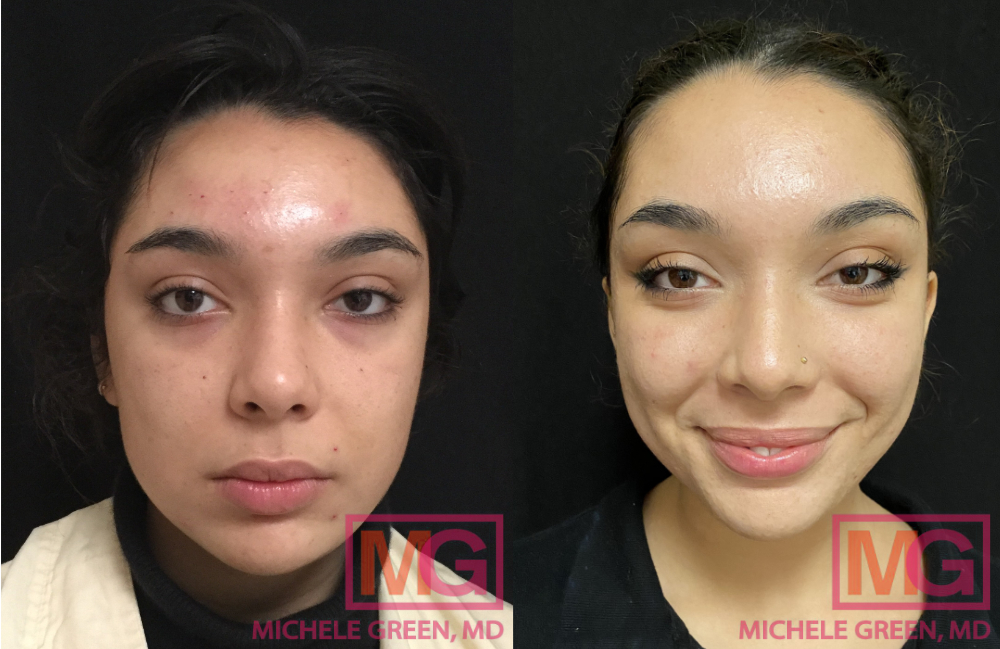
Acne Treatment before and after – 6 months
Do laser treatments help hormonal acne?
According to the American Academy of Dermatology, laser treatments are a promising innovation in acne treatments and can be a practical part of an acne treatment plan. Dr. Green often utilizes the V-Beam laser as a part of acne treatment to reduce inflammatory acne lesions and treat redness and irritation caused by breakouts. V-Beam laser treatment is also an excellent cosmetic option for those suffering from skin conditions like rosacea, broken blood vessels, stretch marks, and post-inflammatory hyperpigmentation left behind from healed acne lesions. The V-Beam laser operates on a 595nm wavelength of light that eliminates acne-causing bacteria and red pigmentation and decreases inflammation. The V-Beam laser also stimulates new collagen production in the treatment area for smoother, firmer skin. After a series of four to six treatment sessions, acne lesions are typically reduced by 85%, and non-inflammatory acne lesions are generally reduced by 70%. There is no downtime associated with the V-Beam laser, making it a safe and effective treatment for reducing hormonal acne, even for patients with sensitive skin.
Another helpful light treatment is photodynamic therapy (PDT), which can kill acne-causing bacteria and shrink the glands responsible for oil production. During PDT, a topical photosensitizer is applied to the skin that is sensitive to a specific wavelength of light. After an incubation period, a light source is applied to the treatment area to activate the photosensitizer, and oxygen radicals are produced to kill the targeted cells. A series of three to five treatments spaced one month apart are required for optimal results. As the skin is still sensitive to light after the procedure, it is essential to avoid direct light or sunlight on the treatment area for one to three days post-treatment.
The Acleara laser is a new, innovative treatment that utilizes intense pulsed light (IPL) to reduce acne-causing bacteria and oil production on the skin’s surface. Simultaneously, vacuum technology is employed to clear the pores of dead skin cell buildup, debris, and bacteria. The light technology additionally works to reduce inflammation and redness from active acne lesions. Acleara laser treatment is not painful, has no downtime, and is highly effective for treating mild to moderate acne breakouts; however, treatment is expensive, and multiple treatments are necessary to achieve and maintain desired results, with frequent recurrent outbreaks.
What other cosmetic procedures help treat hormonal acne?
Dr. Green offers various acne-fighting cosmetic treatments, including facials and chemical peels. One of the most popular acne-fighting treatments in our office is the HydraFacial. The HydraFacial uses a three-step process of cleansing, exfoliating, and infusing intensive serums to fully clear out clogged pores while reducing redness and preventing further outbreaks. Regarding active acne breakouts, the Hydrafacial can be combined with blue light therapy to remove dead skin cells and excess sebum, unclog pores, and kill acne-causing bacteria to reveal a clear complexion. Hydrafacials can also be combined with red light therapy to reduce redness and inflammation on the skin’s surface.
Another popular non-invasive cosmetic procedure is an acne-fighting chemical peel, which uses glycolic or trichloroacetic acids to exfoliate the skin deeply. The peels remove dead skin cells from the skin’s surface and help reveal a healthy layer of skin. They also encourage the generation of new skin cells, which can help rejuvenate the skin, reducing the appearance of scars, fine lines, and sun damage. Dr. Green can customize the formulation with a chemical peel, thus creating a chemical peel tailored to your needs.
How do you treat hormonal acne naturally at home?
Reducing stress, getting adequate sleep, and maintaining a healthy diet can help to prevent hormonal acne. While stress may not directly lead to acne breakouts, elevated cortisol levels can stimulate increased oil production on the skin. Diets rich in low-glycemic foods and omega-3 fat sources and low in milk products can help to reduce insulin levels and inflammation, two factors that can cause hormone fluctuations in the body. Reducing smoking can also help to clear hormonal acne, as many clinical studies have linked adult acne to smoking tobacco. Not only can tobacco cause damage to various organs across the body, but it can also lead to sebum peroxidation. In this process, free radicals attack the fatty acids in sebum, causing broken-down sebum to thicken and clog pores. While the exact process is unknown, smoking tobacco may also result in inflammation and infection of sweat glands.
Practicing proper hygiene and using skincare products with acne-fighting ingredients are also excellent ways to control active acne breakouts at home. However, if you are experiencing persistent or severe hormonal acne, you may need topical or oral medications to eliminate and treat it effectively. A board-certified dermatologist such as Dr. Green can assess the type and severity of your acne breakouts to tailor a treatment plan best suited to your skin concerns and goals.
What does bad hormonal acne look like?
Hormonal acne can look different for each individual. Many individuals experience a combination of acne lesions and severity, although cystic acne is most closely associated with hormonal acne. Cysts form below the skin’s surface and typically do not come to a ‘head’ like other acne lesions. Initially, cystic acne will form when bacteria, excess oil, and dead skin cells clog the skin’s pores and will become increasingly inflamed as the bacteria increases under the skin. Hormonal acne cysts may present as red, swollen, irritated lesions that are tender to the touch. Hormonal acne cysts also tend to affect the lower face and can commonly be found on the chin, jawline, neck, and cheeks. Cystic hormonal acne typically does not respond well to topical treatments since the lesions form at a depth that topicals can not penetrate. Instead, effective treatment for hormonal acne cysts requires oral medications such as Accutane, spironolactone, or oral contraceptives. A board-certified dermatologist, such as Dr. Green in New York, can diagnose your hormonal cystic acne and provide the acne treatments to help you achieve clear skin.
What age is hormonal acne the worst?
Typically, teenagers experience more hormonal acne than other age groups due to hormonal changes during puberty. However, many adults also experience hormonal acne, especially women between the ages of 20 and 40.
How long does a hormonal acne flare-up last?
A pimple caused by a hormonal acne flare-up usually lasts about a week before it resolves, but for some, hormonal acne can lead to frequent breakouts on the skin. Hormonal acne is typically cyclical, though it can be exacerbated by certain life events such as pregnancy and menopause. Although teenage hormonal acne may fade on its own with age, hormonal adult acne often requires acne treatment intervention to restore clear skin.
Does hormonal acne ever go away?
Hormonal acne can be challenging to deal with, as these pimples don’t always respond well to traditional acne treatments. Though a regimen of proper facial hygiene and over-the-counter products can be helpful, patients find that their breakouts are stubborn and do not go away on their own. For this reason, most patients struggling with hormonal acne breakouts turn to an expert, such as board-certified dermatologist Dr. Green, to help reduce and prevent hormonal acne through the use of oral medications and in-office treatments. Additionally, hormonal acne breakouts are often cystic, and cystic acne is closely associated with permanent acne scars. Acne scars develop when inflammation of the lesions causes irreparable damage to the underlying skin tissue. The appearance of acne scars can be improved with cosmetic treatments, although acne scars are often much more challenging to treat than the initial breakouts themselves. Consulting with a board-certified dermatologist like Dr. Green early for your hormonal acne is the best way to get active acne under control and prevent acne scars from forming.
Is hormonal acne curable?
Though hormonal acne is a common form of acne breakout among adults, the cause of hormonal acne varies from patient to patient. At this point, the world of dermatology has not developed a finite cure for hormonal acne. However, hormonal acne is entirely treatable, and with a customized acne treatment plan developed by Dr. Green, hormonal acne can become a thing of the past. Hormonal acne can effectively be managed with the right combination of in-office acne treatments, topical creams, oral medications, and specially formulated skincare products. Dr. Green can help determine the underlying factors contributing to your acne breakouts and provide the appropriate treatment options for achieving and maintaining healthy, smooth, clear skin.
Frequently Asked Questions (FAQs):
How do I know if my acne is bacterial or hormonal?
The best way to determine if your acne is bacterial or hormonal is to consult with an expert dermatologist such as Dr. Green in New York City. Dr. Green will assess the type and severity of acne lesions on your skin and review your medical history. She may also order lab tests to determine if any underlying hormonal imbalances are occurring that may be contributing to the acne breakouts. In some cases, she may additionally order a bacterial culture, taking a small sample from an active lesion that a laboratory for the growth of unusual bacteria analyzes.
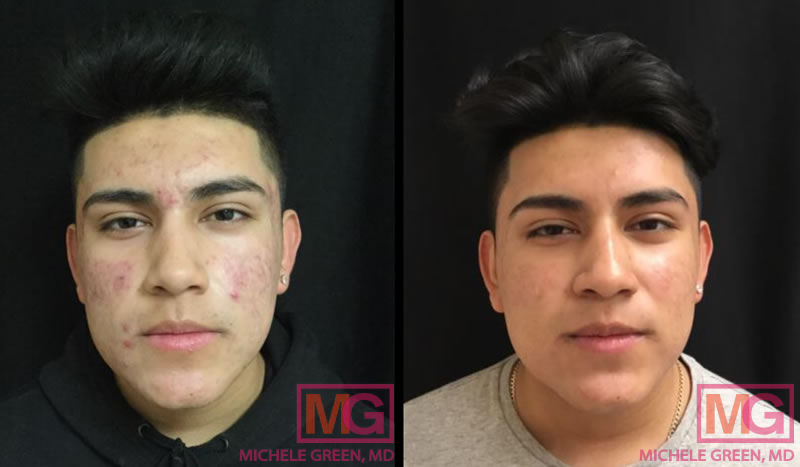
Can men get hormonal acne?
Although hormonal acne is a skin condition most commonly associated with women, men can also experience hormonal acne. Teenage boys and adult men with high levels of testosterone are typically acne-prone, as excess testosterone can stimulate the overproduction of sebum in the sebaceous glands of the skin. When the skin produces too much sebum, it often clogs the pores and becomes trapped with dead skin cells and debris, causing inflammation and acne lesions. Acne, including hormonal acne breakouts, can affect anyone, and it’s essential to seek treatment from a medical professional as soon as possible to prevent acne scars from developing, as they are often much more challenging to treat than acne breakouts themselves.
Can you get hormonal acne from your period?
Adult women are more likely than men to develop hormonal acne due to hormone fluctuations that occur throughout the month. In the second half of the menstrual cycle, progesterone levels increase, causing an increase in oil production in the skin and pores to swell shut, trapping excess sebum, dead skin cells, and other debris. Period acne breakouts tend to affect the lower half of the face and can commonly be found on the jawline, chin, cheeks, and neck. If your acne breakout is related to your menstrual cycle, it’s most likely to flare the week before or during your period. A dermatologist like Dr. Green in NYC may recommend acne treatments such as spironolactone, oral contraceptives, or a combination of targeted skincare products to combat hormonal acne that flares due to the menstrual cycle.
Can smoking cause hormonal acne?
Yes, there is clinical evidence that links adult acne to smoking tobacco. Smoking tobacco is known to cause damage to various organs in the body. Tobacco use can also cause acne and harm the skin by impacting sebum production, depleting vitamin E from the blood, and leading to sebum peroxidation, which entails free radicals attacking fatty acids in sebum. This causes the sebum to break down and thicken, clogging the pores and causing breakouts. Vitamin E is an antioxidant that prevents sebum peroxidation, and when vitamin E levels are depleted by tobacco use, sebum peroxidation is more likely to occur. Tobacco usage can also lead to apocrine (sweat) glands becoming infected and inflamed, although the exact underlying cause of this is largely unknown.
Should you pop hormonal acne?
Never! Popping or picking at hormonal acne (and all other types of acne) can increase inflammation, which leads to worsening breakouts and the potential for developing hyperpigmentation, infection, and acne scarring. Rather than attempting your extractions at home, schedule a consultation with a board-certified dermatologist, Dr. Michele Green, in New York. Dr. Green has over two and a half decades of experience at the forefront of dermatology and will work with you to create a customized acne treatment plan that best suits your specific needs. When you consult with Dr. Green, she will determine the underlying causes of your acne and how to treat your breakouts best. Specific blood tests may be ordered to evaluate hormone levels, as hormone fluctuations can cause acne.
What vitamin is best for hormonal acne?
Some patients choose to take advantage of the benefits of oral Zinc supplements for combatting stubborn acne breakouts. Zinc is a natural anti-inflammatory agent that can help reduce skin irritation associated with breakouts and help control oil production. Vitamins A, B, C, and E can also help treat acne by maintaining normal hormone levels, reducing inflammation, and acting as antioxidants to support general skin health. However, most hormonal acne breakouts cannot be controlled by vitamins alone. It is best to consult with a board-certified dermatologist such as Dr. Green to discuss treatment options to get your hormonal acne under control.
What can I drink to clear hormonal acne?
There are no specific drinks that can help to clear hormonal acne. Anti-inflammatory or antioxidant teas such as green, ginger, and chamomile teas can help to reduce inflammation and create healthy skin; however, there are no clinical studies linking these teas to acne treatment. It is best to avoid high-glycemic drinks like soda as quickly raising blood sugar can affect hormone levels and contribute to acne.
Will I have hormonal acne forever?
While many cases of teenage hormonal acne may resolve independently with time, untreated adult hormonal acne can persist for years or even a lifetime. Untreated breakouts, especially cysts, can permanently damage the underlying skin tissue, creating acne scars that are even more difficult to treat than the initial breakouts. In addition, hormonal acne can be a particularly challenging type of acne to treat, as it often does not respond well to topical acne treatments. The best course of action is to schedule a consultation with an experienced board-certified dermatologist, such as Dr. Michele Green, in New York City. Dr. Green will physically evaluate your skin condition, collect a thorough medical and family history, and review prior acne treatments you’ve undergone. Blood tests may be ordered to evaluate any irregular hormone levels. Dr. Green will then develop a personalized acne treatment plan that leaves you with smooth, clear, healthy skin that lasts.
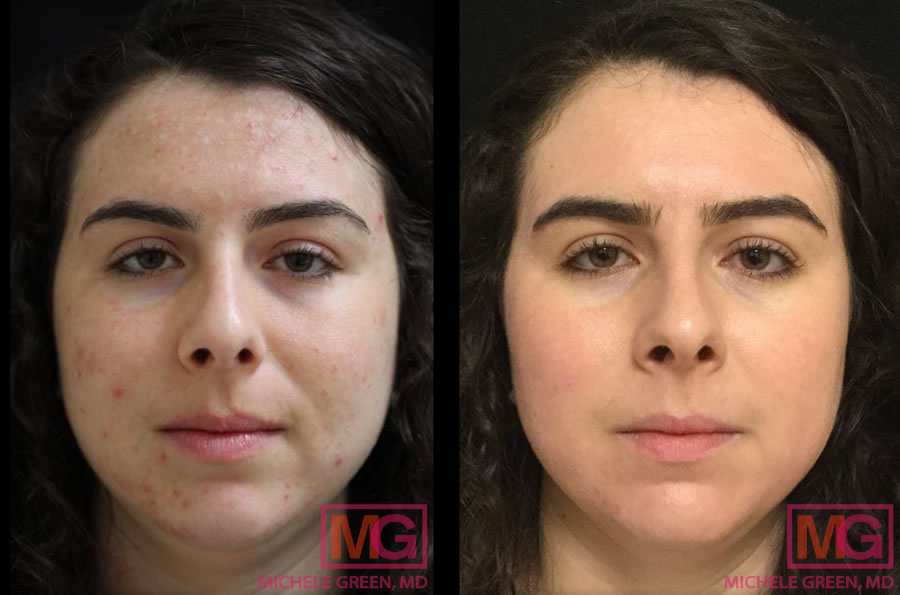
How can I balance my hormones to reduce acne?
Oral medications are often the best way to balance hormones and reduce hormonal acne. For women, birth control pills can help to regulate estrogen and progesterone levels, while oral spironolactone can help to reduce androgen hormone levels for clear skin. Women undergoing menopause can turn to hormone replacement therapy, which utilizes a mixture of creams, gels, pills, and patches to replace reduced levels of estrogen and progesterone. Individuals with thyroid conditions can work with an endocrinologist, taking medications such as levothyroxine for hypothyroidism to regulate thyroid hormones and reduce acne breakouts. The treatment plan best suited for you will depend on the cause of your hormonal acne. Dr. Green will assess your medical history and laboratory results to formulate a plan of oral or topical medications to reduce your acne for clear, radiant skin.
Will doxycycline treat hormonal acne?
Doxycycline is an oral antibiotic that treats acne by inhibiting the growth of acne-causing bacteria and reducing inflammation. While doxycycline and other tetracycline antibiotics are often the first choice for treating breakouts, hormonal acne in adult women does not always resolve with doxycycline. In fact, adult hormonal acne often doesn’t respond well to oral antibiotics, topical antibiotics, or retinoid creams. Many patients with hormonal acne benefit from other acne treatment options, such as oral contraceptives or spironolactone. Most patients rely on a combination of hormonal acne treatments to achieve and maintain clear skin. Dr. Green will work with you to develop an acne treatment plan that best suits your needs.
Why hormonal acne won’t go away
When hormonal acne doesn’t go away, the acne treatments are likely ineffective in targeting the specific causal factors contributing to the breakouts. Patients with hormonal acne may develop a breakout after years of having clear skin. If you struggle with persistent hormonal acne or recurrent breakouts, consult Dr. Green in New York City, who will work with you to determine the underlying factors contributing to your hormonal breakouts and select the acne treatment options best suited to your needs. After starting hormonal acne treatment, it may take up to six weeks to see improvement in your skin condition. This remains true for topical treatments and oral medications, as regulating hormones or eliminating acne-causing bacteria takes some time. The sooner you consult with an expert like Dr. Green, the sooner you can achieve a healthier, smoother, clearer complexion.
How to get rid of hormonal acne overnight?
Getting rid of hormonal acne is a process that can take some time. The fastest way to get rid of hormonal acne is to consult a board-certified dermatologist like Dr. Michele Green in NYC. Since there are many potential causes of hormonal acne, it is essential first to determine the underlying causes contributing to hormonal acne breakouts to choose the right combination of treatment options. When you consult with Dr. Green in Manhattan’s Upper East Side neighborhood, she will work with you to determine whether your breakouts are related to hormonal acne and what the causes may be. She will then develop with you a customized hormonal acne treatment plan that incorporates a combination of specially formulated skin care products, oral medications, in-office procedures, and topical treatments that are best suited to your skin condition.
How I got rid of my hormonal acne
While hormonal acne is often thought of as “teenage acne,” many adults suffer from persistent hormonal acne breakouts, which can lead to lower self-esteem and self-confidence. Hormonal acne can be related to changes such as menstruation, menopause, changing or discontinuation of birth control, and pregnancy. While it can be particularly challenging to treat, Dr. Green offers a variety of oral medications, topical creams, in-office treatments, and acne-targeting skincare products to get hormonal acne breakouts under control for healthy, radiant, clear skin. With many treatment options to choose from, it can be difficult to know which treatments will be best for you, which is why the best first step for hormonal acne treatment is to schedule an appointment with expert dermatologist Dr. Michele Green.
Dr. Michele Green in New York City is an internationally renowned board-certified dermatologist with over two and a half decades of experience providing some of the most discerning men and women from around the globe with the best non-invasive treatment options available, including oral medications, V-Beam laser, and targeted skincare products for acne breakouts and acne scars. Dr. Green is consistently identified as one of New York’s best dermatologists by Castle Connolly, New York Magazine, Super Doctors, and The New York Times due to her dedication to her patients and expertise. Dr. Green can provide a personalized solution that helps, leaving you looking and feeling like the best version of yourself. To schedule a consultation with Dr. Green and learn more about the perfect hormonal acne treatment plan for you, contact us online or call our NYC-based office at 212-535-3088.
 212-535-3088
212-535-3088 